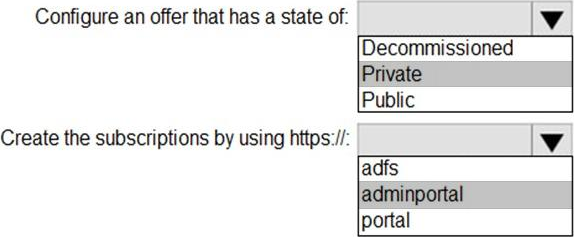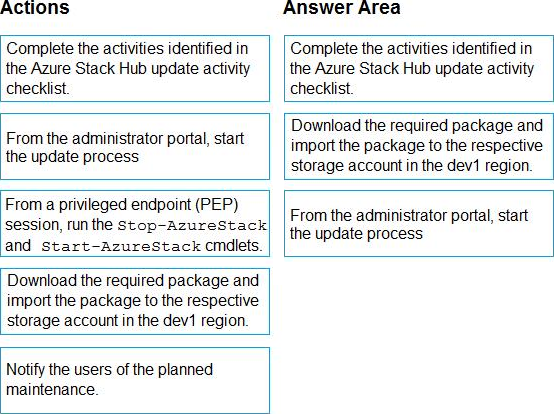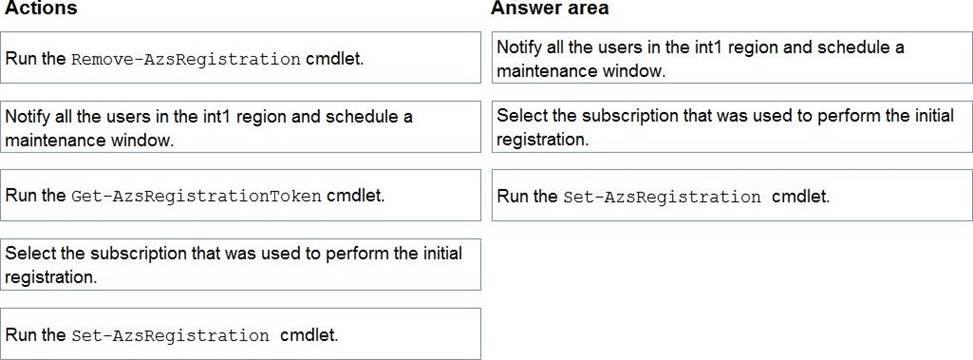Microsoft AZ-600 Configuring and Operating a Hybrid Cloud with Microsoft Azure Stack Hub Online Training
Microsoft AZ-600 Online Training
The questions for AZ-600 were last updated at Apr 21,2025.
- Exam Code: AZ-600
- Exam Name: Configuring and Operating a Hybrid Cloud with Microsoft Azure Stack Hub
- Certification Provider: Microsoft
- Latest update: Apr 21,2025
Topic 1, Litware Office
Case study
This is a case study. Case studies are not timed separately. You can use as much exam time as you would like to complete each case. However, there may be additional case studies and sections on this exam. You must manage your time to ensure that you are able to complete all questions included on this exam in the time provided.
To answer the questions included in a case study, you will need to reference information that is provided in the case study. Case studies might contain exhibits and other resources that provide more information about the scenario that is described in the case study. Each question is independent of the other questions in this case study.
At the end of this case study, a review screen will appear. This screen allows you to review your answers and to make changes before you move to the next section of the exam. After you begin a new section, you cannot return to this section.
To start the case study
To display the first question in this case study, click the Next button. Use the buttons in the left pane to explore the content of the case study before you answer the questions. Clicking these buttons displays information such as business requirements, existing environment, and problem statements. If the case study has an All Information tab, note that the information displayed is identical to the information displayed on the subsequent tabs. When you are ready to answer a question, click the Question button to return to the question.
Overview
Existing Environment
Network Environment
The Litware offices and the Fabrikam office connect by using a private circuit. Each office connects directly to the Internet.
Identity Environment
The Litware network contains an Active Directory forest named litwareinc.com. The forest and an Azure Active Directory (Azure AD) tenant named litwareinc.com are integrated by using Active Directory Federation Services (AD FS). Litware has an enterprise certification authority (CA).
The Azure subscriptions of Litware are associated to the litwareic.com Azure AD tenant.
Fabrikam also has an Azure AD tenant.
Azure Stack Hub Environment
Litware has the following two Azure Stack Hub integrated systems:
✑ A fully operational integrated system in Boston that connects to the Internet and has the following configurations:
– Is managed by using an administrator management endpoint of: https://adminportal.eastus.litwareinc.com
– Has an Azure App Service deployment that has two dedicated, large web workers
– Currently uses version 2005 of Azure Stack Hub
✑ A newly delivered integrated system in Chicago that is disconnected from the Internet and will be managed by using an administrator management endpoint of: https://adminportal.northcentralus.litwareinc.com
Datacenter Environment
The Chicago datacenter of Litware contains the infrastructure shown in the following table.

Current Problems
During heavy usage, requests to App Service in Boston fail despite low utilization of the web workers.
Requirements
Planned Changes
Litware plans to implement the following changes:
✑ Deploy an Event Hubs resource provider to the integrated system in Boston.
✑ Make Azure Functions available to Azure Stack Hub users in Boston.
✑ Prepare the integrated system in Chicago to be production-ready.
Technical Requirements
Litware identifies the following technical requirements:
✑ Implement an infrastructure to support Azure Functions on the integrated system in Boston.
✑ Provision the certificates required to deploy the Event Hubs resource provider to the integrated system in Boston.
✑ Configure an identity provider for the integrated system in Chicago.
✑ Locate the IP address of the privileged endpoint (PEP) of the integrated system in Chicago.
✑ Ensure that only operators have control over the creation of subscriptions on the integrated system in Chicago.
✑ Provision a certificate to provide access to the Azure Resource Manager endpoint of the integrated system in Chicago.
✑ Identify which PowerShell setting on CLIENT1 and CLIENT2 must be modified to register the integrated system in Chicago.
✑ Implement a management app that will use Azure Resource Manager to inventory the resources of the integrated system in Chicago.
Security and Compliance Requirements
Litware has the following security and compliance requirements:
✑ All infrastructure software must run the latest version, including hotfixes.
✑ Litware must have control over certificate revocations.
Business Requirements
Litware wants to ensure that the users at Fabrikam have secure access to the workloads on the integrated system in Boston.
Updates and Hotfixes
The current hotfixes and updates available for Azure Stack Hub are:
✑ 2005
✑ 2005 hotfix 1
✑ 2005 hotfix 2
✑ 2005 hotfix 3
✑ 2008
✑ 2008 hotfix 1
✑ 2008 hotfix 2
✑ 2011 (latest version)
You need to identify the PEP information for the integrated system in Chicago. The solution must meet the technical requirements.
What should you use?
- A . the HLH configuration file
- B . the Get-AzsRegistrationToken cmdlet
- C . Properties on the Region management blade of the administrator portal
- D . the Help + support blade of the administrator portal
HOTSPOT
You need to identify the authentication and authorization process for the integrated system in Chicago. The solution must meet the technical requirements.
What should you include in the solution? To answer, select the appropriate options in the answer area. NOTE: Each correct selection is worth one point.

HOTSPOT
You need to implement the App Service infrastructure to address the current issues and support the planned changes for Azure Functions in Boston.
What should you do? To answer, select the appropriate options in the answer area. NOTE: Each correct selection is worth one point.

HOTSPOT
You need to identify the certificate for the integrated system in Chicago. The solution must meet the technical requirements.
What should you identify? To answer, select the appropriate options in the answer area. NOTE: Each correct selection is worth one point.

HOTSPOT
You need to register the northcentralus region.
How should you complete the command? To answer, select the appropriate options in the answer area. NOTE: Each correct selection is worth one point.

HOTSPOT
You need to identify the procedure for creating the subscriptions on the integrated system in Chicago. The solution must meet the technical requirements.
What should you include in the solution? To answer, select the appropriate options in the answer area. NOTE: Each correct selection is worth one point.
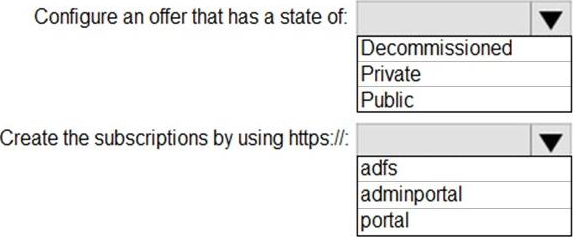
You need to implement the management app. The solution must meet the technical requirements.
What should you use?
- A . a PowerShell session to litwareinc.com
- B . a browser session to litwareinc.com
- C . a PowerShell remoting session to the PEP
- D . a browser session to the administrator portal
Topic 2, Northwind Traders
Case study
This is a case study. Case studies are not timed separately. You can use as much exam time as you would like to complete each case. However, there may be additional case studies and sections on this exam. You must manage your time to ensure that you are able to complete all questions included on this exam in the time provided.
To answer the questions included in a case study, you will need to reference information that is provided in the case study. Case studies might contain exhibits and other resources that provide more information about the scenario that is described in the case study. Each question is independent of the other questions in this case study.
At the end of this case study, a review screen will appear. This screen allows you to review your answers and to make changes before you move to the next section of the exam. After you begin a new section, you cannot return to this section.
To start the case study
To display the first question in this case study, click the Next button. Use the buttons in the left pane to explore the content of the case study before you answer the questions. Clicking these buttons displays information such as business requirements, existing environment, and problem statements. If the case study has an All Information tab, note that the information displayed is identical to the information displayed on the subsequent tabs. When you are ready to answer a question, click the Question button to return to the question.
Overview
A company named Northwind Traders has a main office and a datacenter. All development occurs at the main office.
Existing Environment
Identity Environment
The network contains an Active Directory forest named northwind.com. The forest and an Azure Active Directory (Azure AD) tenant named northwind.onmicrosoft.com are integrated by using Active Directory Federation Service (AD FS).
All Azure subscriptions use the northwind.onmicrosoft.com Azure AD tenant.
Northwind Traders uses an Enterprise Agreement (EA) subscription.
All operators are global administrators in northwind.onmicrosoft.com.
Azure Stack Hub Environment
Northwind Traders has the following five Azure Stack Hub integrated systems:
✑ One integrated system that connects to an internet-facing network and has the following configurations:
– The region name is int1.
– The operators do not have access to the user subscriptions.
– The integrated system is used for customer and partner applications.
– The partners and customers of NorthWind Traders use guest user accounts to access various user resources.
✑ Two integrated systems that connect to a private network, are accessed only from inside the company, and have the following configurations:
– The integrated systems are dedicated to research and development.
– One integrated system has a region name of priv1, and the other has a region name of priv2.
– The integrated systems are used for various data rendering, AI workloads, inference, and data visualization.
✑ Two integrated systems that are dedicated to application development and have the following configurations:
– The integrated systems are disconnected from the Internet. The workloads in the user subscriptions have Internet access.
– One integrated system has a region name of dev1, and the other has a region name of dev2.
– Both regions are used only by developers at Northwind Traders.
The external domain name of all the integrated systems is northwind.com. All the integrated systems have Azure App Service and the Azure Kubernetes Service (AKS) engine deployed.
The computer of the operator in each region has all the prerequisite software installed for managing Azure Stack Hub.
Current Problems
You identify the following issues in the current environment:
✑ The priv2 region recently experienced a catastrophic failure.
✑ The developers report high chargeback costs for the dev1 region.
✑ The int1 region runs a high number of Windows virtual machines that use pay-as-you-use images.
✑ The Northwind Traders partners and customers report that use of the guest user accounts is too complex.
✑ Users in the priv1 region recently deployed NCas_v4 virtual machines for various AI workload. The users discover that the virtual machines do not use GPUs.
Requirements
Planned Changes
Northwind Traders plans to implement the following changes:
✑ Remove all guest user accounts.
✑ Change the DNS forwarder of the priv1 region.
✑ Change the billing model and registration name of the int1 region.
✑ After the catastrophic failure, restore the priv2 region to its original state.
✑ Provide each partner with its own dedicated user subscription that will use its own dedicated Azure AD tenant.
Technical Requirements
Northwind Traders identifies the following technical requirements:
✑ Minimize hardware and software costs.
✑ Standardize all datacenter workloads on Azure Stack Hub.
✑ In the priv1 region, implement a disaster recovery plan for App Service.
✑ Whenever possible, implement solutions by using the minimum amount of administrative effort.
✑ In the dev2 region, update the AKS Base Ubuntu image to the latest version in Azure Stack Hub Marketplace.
✑ Whenever possible, implement solutions by using built-in tools, features, and services without acquiring additional third-party tools.
✑ For the users’ virtual machines and the associated resources in the dev1 and dev2 regions, implement a business continuity and disaster recovery plan that includes an automated failback process.
✑ If changes to the Azure Stack Hub infrastructure cause workload downtime outside of planned maintenance windows, notify all users in the region where the downtime occurred and schedule a maintenance window.
DRAG DROP
You schedule a planned maintenance window.
You need to perform an Azure Stack Hub update in the dev1 region. The solution must meet the technical requirements.
Which three actions should you perform in sequence? To answer, move the appropriate actions from the list of actions to the answer area and arrange them in the correct order.
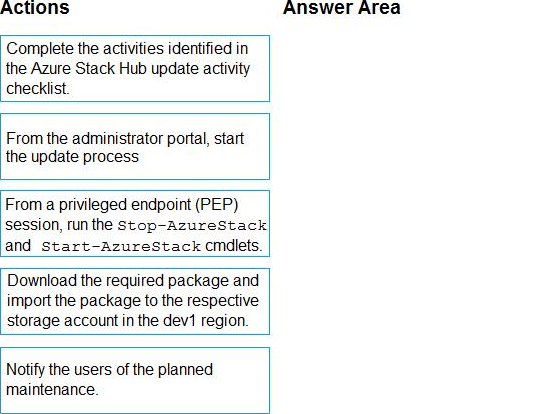
You need to recommend a business continuity and disaster recovery plan for the dev1 and dev2 regions that meets the technical requirements.
Which two recommendations should you make? Each correct answer presents part of the solution. NOTE: Each correct selection is worth one point.
- A . Implement the Infrastructure Backup Service
- B . Use an Azure Marketplace backup tool in each region to protect the virtual machines that run in the other region
- C . Implement Azure Site Recovery
- D . Use Infrastructure as Code (IaC) by using Azure Resource Manager templates
DRAG DROP
You need to change the int1 region to use the capacity model. The solution must meet the technical requirements.
Which three actions should you perform in sequence? To answer, move the appropriate actions from the list of actions to the answer area and arrange them in the correct order.
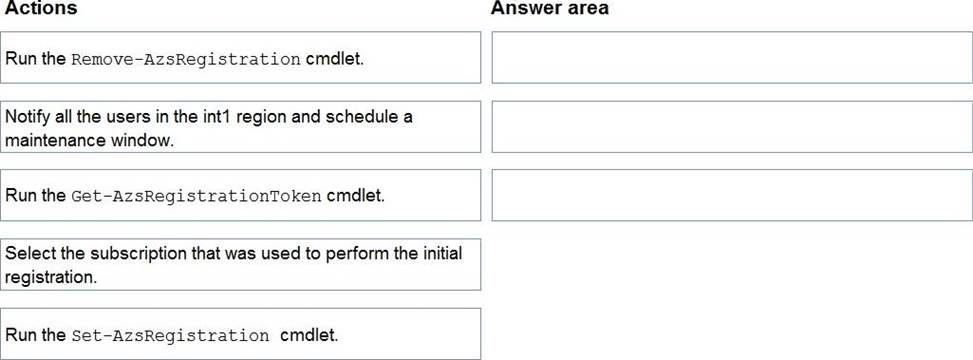
Latest AZ-600 Dumps Valid Version with 73 Q&As
Latest And Valid Q&A | Instant Download | Once Fail, Full Refund





